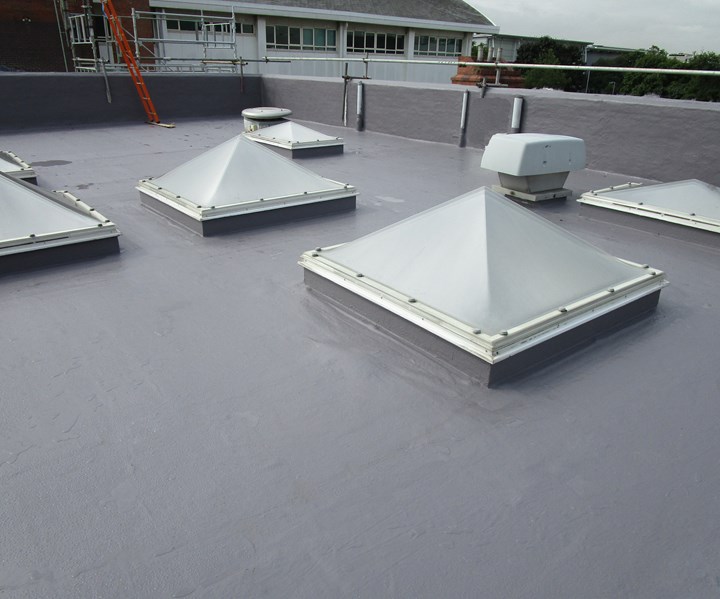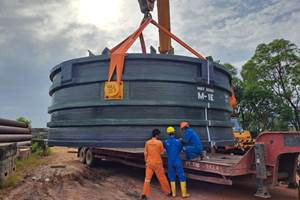AOC resins support manufacture of emergency hospital wards
Rapidly built emergency hospital wards built in response to the coronavirus outbreak incorporate AOC resins in a pre-fabricated roofing system.

Source | AOC
Resins from composites industry supplier AOC (Schaffhausen, Switzerland) have enabled construction of high-strength temporary emergency hospital wards in the U.K.
In response to the COVID-19 outbreak, among its efforts the British National Health Service (NHS) has commissioned the building of several emergency hospital wards around the United Kingdom in recent months. Although the wards intended for temporary use during the COVID-19 crisis, the buildings have been designed to have a 20-25-year life expectancy, and must, by necessity, have a high level of building integrity and dimensional stability to deliver high-quality protection for patients and medical personnel.
To enable their rapid construction, many of these wards are built from prefabricated units, which are combined at the construction site into a larger building. The roof of these hospitals must be durable, water-tight and able to seal the joints between the building’s modules.
Roofing solutions specialist Roberts Manufacturing’s Protec roofing system, developed in close collaboration with AOC, were chosen for the wards. As a cold-applied liquid roofing system, there are no open-flame techniques involved in Protec’s installation, eliminating risks of accidental fire or heat-related injury. In addition, the liquid roofing system was ideal for sealing the many joints between the ward modules, creating a waterproof membrane with no laps, welds or weak points between the roof sections. Due to the Protec system’s inherent flexibility, the structural expansion and contraction movements across the 1,300-square-meter roof area provided no issues to the integrity of the membrane.
“AOC developed a resin that enables our liquid-applied roofing system to enjoy the ideal combination of properties, including flexibility, toughness, speed of installation and long-term weathering performance.”
According to AOC, another key feature is the rapid installation times afforded by the polymer-modified technology. The roofing system is able to cure from a liquid to a robust membrane in under 1 hour, meaning the off-site waterproofing of the modules and the in-situ jointing works can be completed with high speed. The Synolite resin used for this application is a key constituent of the system’s complex formulation, offering great inherent ductility and easy on-site application.
“Our collaboration with AOC, which we have been enjoying for many years, has proven to be highly successful on many levels,” says David Roberts, managing director of Roberts Manufacturing. “They developed a resin for us that enables our liquid-applied roofing system to enjoy the ideal combination of properties, including flexibility, toughness, speed of installation and long-term weathering performance.”
As the COVID-19 outbreak spread in Europe at a very fast rate, the decision for the NHS to build the emergency hospital wards was made quickly. This left Roberts Manufacturing very little time to source its raw materials and be properly prepared for the demands of these projects.
“We were heavily relying on AOC to deliver the goods in a short period time,” Roberts says. “But they did great! Despite a challenging production planning related to COVID-19, the product was made with priority and effectively transported to us, in spite of all the heavy cross-border formalities in place at the moment. This effort by AOC ultimately proved a key factor in the ability of the NHS to deliver these emergency wards on time.”
Roberts Manufacturing has already waterproofed several emergency hospital wards in the United Kingdom, with some additional ones in the pipeline.
Related Content
Pultron Composites GFRP rebar addresses facility, marina project challenges
The company’s Mateenbar GFRP rebar has led to more durable solutions for production of a new medical research center, and to improve structures regularly exposed to harsh marine conditions.
Read MoreGFRP Tech launches South African facility for GFRP rebar production
Said to be the first of its kind in this region, GFRP Tech will manufacture, test and supply flagship EnviraBar and EnviraMesh products to support South Africa’s infrastructure modernization.
Read MoreNorco GFRP molds meet high-quality cast concrete beam production needs
A project with P&M successfully achieved manufacture of six 20-meter-long architectural beams for an R&D facility with near-seamless surfaces and on a tight production schedule.
Read MoreComposites end markets: Infrastructure and construction (2024)
Composites are increasingly used in applications like building facades, bridges, utility poles, wastewater treatment pipes, repair solutions and more.
Read MoreRead Next
Cutting 100 pounds, certification time for the X-59 nose cone
Swift Engineering used HyperX software to remove 100 pounds from 38-foot graphite/epoxy cored nose cone for X-59 supersonic aircraft.
Read MoreNext-gen fan blades: Hybrid twin RTM, printed sensors, laser shock disassembly
MORPHO project demonstrates blade with 20% faster RTM cure cycle, uses AI-based monitoring for improved maintenance/life cycle management and proves laser shock disassembly for recycling.
Read MoreCeramic matrix composites: Faster, cheaper, higher temperature
New players proliferate, increasing CMC materials and manufacturing capacity, novel processes and automation to meet demand for higher part volumes and performance.
Read More.jpg;width=70;height=70;mode=crop)












